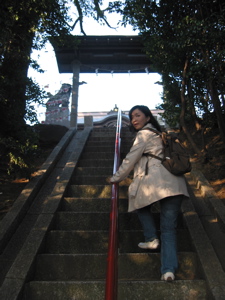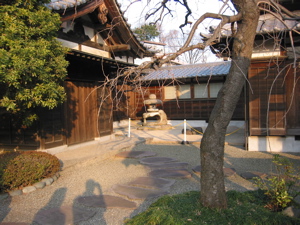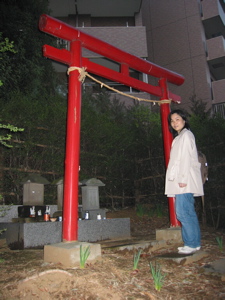
March 5th 2007
Sundays are the day that both Yuriko and I have off, and yesterday's weather was beautiful, perfect for a walk. Thus, we went for a walk in the local area, following another of the routes in the guidebook to our ward of Kawasaki. We've done all the ones that start near home, so we got a bus to the starting point. We did consider walking, because Yuriko is prone to travel sickness at the moment, but in the end the balance went in favour of not walking an extra couple of kilometres. That was slightly odd, because we got on the bus at the stop where we normally get off.
The walk started at a railway station, and the first stop was a shrine. At first, we thought it was called "Hachiman Jinja", but we later came to the conclusion that it was actually called "Yawata Jinja"; the characters are exactly the same, and "Hachiman" is the normal reading, but the flower shop next door read them as "Yawata", as made clear by the latin letter signboard, which suggests that that is the correct reading in this case.
The shrine is up a steep flight of steps that runs between shops and blocks of flats, and there is very little greenery at the top. There are a few trees, because every shrine needs a sacred grove, but it really was more of a formality than anything else.
 Yuriko climbing the steps to Tsuchihashi Jinja.
Yuriko climbing the steps to Tsuchihashi Jinja.
The next stop was another shrine, this one somewhat larger. It is called Tsuchihashi Jinja, which means "Earth Bridge Shrine", apparently because Yoritomo Minamoto, the first Kamakura Shogun, built an earth bridge in the vicinity, which gave its name to the village, which ultimately gave its name to the shrine, when the shrine was established about four hundred years ago.
Tsuchihashi Jinja has rather more greenery around it, particularly around the main entrance, which is up a steep flight of stone steps. Indeed, the overall atmosphere was very pleasant. Apparently the priest from Shirahata-san goes there to perform the sacred dance for Tsuchihashi Jinja's main festival, and I get the impression that Shirahata-san is the main shrine in this area. Overall, I think it's the nicest.
The route from Tuchihashi Jinja took us along a "river", which is really small and now confined to an absolutely regular concrete channel, so it's more like a culvert. Since it is called a river, it presumably is natural in origin, even if there's little evidence left of that. As we went along this road, we passed a fair number of very large, nice-looking houses, in one case with steps leading up to the main gate that took up about as much area as our living room. Ah well, if I manage to write something successful...
 A quiet corner of Kawasaki.
A quiet corner of Kawasaki.
The next point of interest was a temple, Seifukuji. This place is quite small, but it does have a nice garden, and one corner of the grounds, which I photographed, has a very Japanese atmosphere. There didn't seem to be anyone around, however, even though there is a house for resident monks.
The temple had six stone Jizos lined up, and, unusually, they were all carved in different styles. A set of six is quite common; I believe that there is one Jizo for each of the worlds, and each saves souls trapped in that world. However, they are normally carved in the same style, as a set. The ones at Seifukuji seem to have been gathered over quite some time.
By this point Yuriko was a bit tired, so we abbreviated the prescribed route and headed for a small park. This proved to be right at the top of a hill; it includes a triangulation point. Fortunately, there were some benches for Yuriko to sit on after the climb, and the view out over Kawasaki to Tokyo was quite spectacular. The weather was a bit hazy, so the view of Shinjuku was not as clear as it might be, but it really was a good view. All built up, of course, but such landscapes have their own appeal.
 Yuriko in front of the small shrines by the flats.
Yuriko in front of the small shrines by the flats.
The next step was to plan the most direct route home. This was a little trickier than it could ahve been, due to the presence of two major roads with limited crossing points, but I worked something out, and it did seem to end up being fairly direct. Along the way, we passed a bamboo grove beside a block of flats, and Yuriko spotted a red torii inside it. There was a path, with steps, up the slope, so we went to have a look.
The torii stood in front of three tiny stone shrines, one of which was clearly an Inari shrine, as it had two ceramic foxes in front of it. (Red torii are also characteristic of Inari shrines.) The place had a slightly strange atmosphere, as it was sandwiched between large, modern buildings, very close to the expressway, and yet still somewhat dark and mysterious within the stand of bamboo. Through the stems, we could also see a small graveyard, apparently also still tended.
There seem to be quite a few little places like this in Japan, like the small Jizo by one of the bus stops near our house, which always seems to be decorated with origami cranes. It is fun to walk around and stumble over them.
From there, we crossed the expressway, and stopped off for ramen on the way home. Yuriko was feeling fine at that point, so we had a nice meal, and then walked the rest of the way back.
We're about half way through the walks in the guidebook now; I wonder whether we'll be able to finish them while there's still just the two of us. Miyamae ward is very hilly, so I don't relish the idea of doing most of the walks with a push-chair. It's nice to get to know our area a bit better, and it's still proving to be a nice area.